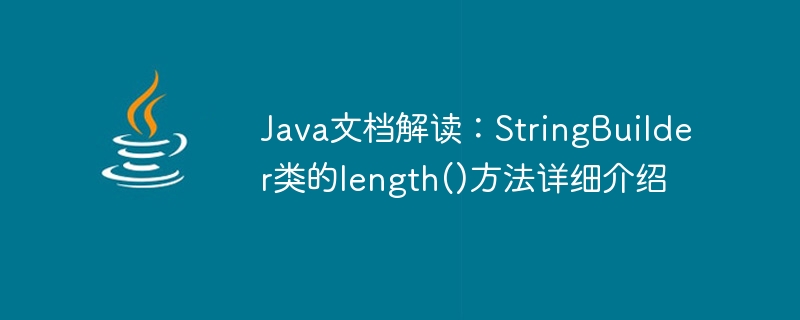

Interpretation of Java documentation: A detailed introduction to the length() method of the StringBuilder class, specific code examples are required
Introduction:
In Java programming, string processing It is a very common operation. The StringBuilder class is a variable class provided by Java for operating strings. It provides a series of convenient methods to perform operations such as string splicing, insertion, and deletion. Among them, the length() method is an important method in the StringBuilder class, used to obtain the length of a string. This article will introduce the length() method of the StringBuilder class in detail and provide corresponding code examples.
The definition and basic usage of the StringBuilder class:
The StringBuilder class is a class under the Java.lang package and has a variable character sequence. Strings can be modified using this class. The StringBuilder class provides a series of methods, for example: the append() method is used to add content to the string, the delete() method is used to delete characters in the string, the insert() method is used to insert content in the string, etc. In addition to these common methods, the length() method is used to obtain the length of the character sequence in the StringBuilder object.
length() method introduction: The
length() method is an important method in the StringBuilder class, used to obtain the length of a character sequence. This method does not have any parameters and returns a value of type int, indicating the length of the character sequence.
Code example:
The following is a simple code example showing the use of the length() method of the StringBuilder class:
public class StringBuilderExample {
public static void main(String[] args) {
StringBuilder sb = new StringBuilder("Hello");
int length = sb.length();
System.out.println("字符序列的长度为:" + length);
sb.append("World");
length = sb.length();
System.out.println("添加内容后,字符序列的长度为:" + length);
}
}Running the above code will output the following results:
字符序列的长度为:5 添加内容后,字符序列的长度为:10
Code analysis:
First, a StringBuilder object sb is created, whose initial value is "Hello". By calling the length() method of sb, the length of the character sequence is obtained and assigned to the variable length. Then, by calling the append() method of sb, the content "World" is added to the string. Call the length() method of sb again to obtain the new character sequence length and assign it to the variable length. Finally, use the System.out.println() method to output the results to the console.
Summary:
This article introduces the length() method of the StringBuilder class in Java in detail and provides corresponding code examples. Through the length() method, we can easily obtain the length of the character sequence in the StringBuilder object. In the actual programming process, we can perform corresponding operations based on the length of the string, such as determining whether the string is empty, limiting the maximum length of the string, etc. I hope this article can help readers better understand and use the StringBuilder class in Java.
The above is the detailed content of Java documentation interpretation: Detailed introduction to the length() method of the StringBuilder class. For more information, please follow other related articles on the PHP Chinese website!
